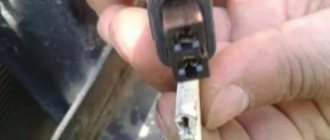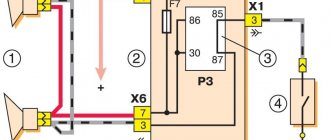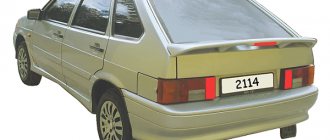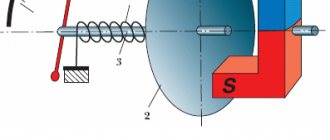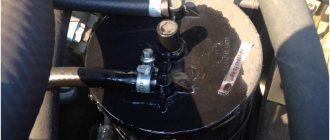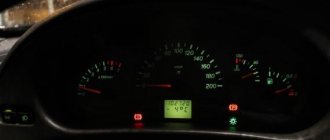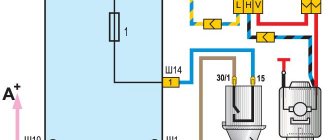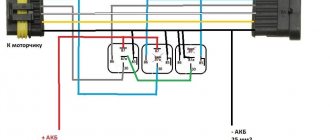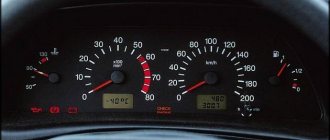VAZ sound signal does not work
A non-functioning horn on a car is a very dangerous malfunction.
The most unpleasant thing is that they find out about this breakdown just when the signal is needed most - in a dangerous situation on the road. What could cause the signal to fail? There are several reasons why the horn may stop working. Almost all of them are electrical and simply involve no contact where it should be. Let's go through them all:
Horn fuse blown
The very first and easiest check that can be performed when the sound signal is not working is the integrity of the fuse. If it turns out to be burnt out, then there may be a short circuit in the car. Try inserting a whole fuse that matches the rating (How to choose a fuse. Colors and ratings). If it burns out in the same way, it means there is actually a short circuit. If not, then perhaps the fuse has simply exhausted its resource and you should pay attention to other reasons.
The horn button does not work
The signal in most cars is turned on by a button in the center of the steering wheel. There are variations with a button in the steering column switch or a certain position of this switch itself, but this is rare.
There are actually a whole bunch of places inside the steering wheel where contact can be lost, leading to the failure of the horn. To understand exactly where they can be located, you need to understand how the sound signal in the car turns on. Let's look at the diagram.
Diagram for connecting an audio signal via a relay
This circuit assumes the presence of a signal activation relay. This relay is found on all modern cars. On a certain category of cars (for example, VAZ classics), there is no relay. In this case, the signal is connected directly through the button on the steering wheel.
The diagram shows that there are two electrical circuits: control and power. The power circuit feeds the signal and does not come into the car interior; the control circuit, on the contrary, comes to the steering wheel. When you press the signal button, the control contacts of the relay close, connect the power circuit and the signal turns on. What are relays, control and power contacts, read the article: how a relay works in a car .
The control current from the relay is transmitted from the steering column to the steering wheel through a floating contact. There may be one, or maybe two. These contacts rub against a special conductive ring built into the steering wheel at the point where it is attached to the steering shaft. Due to the fact that the contacts are spring-loaded, they are constantly pressed against the ring, ensuring the transmission of current to the steering wheel in any position.
Then the voltage is transmitted through a short wire to the button and when it is pressed, the electrical circuit closes to ground - the signal turns on. Now about malfunctions that can occur in the steering wheel.
ATTENTION!
It is better to entrust all work related to disassembling the steering wheel on cars with airbags to a car service center. Unskilled actions can cause the airbag to deploy, which can lead to life-threatening injuries!
– Worn contacts
The pressure contacts on the steering column rub against the slip ring whenever you move the steering wheel and wear out over time. Sooner or later, a moment may come when they can no longer reach the contact ring on the steering wheel and then pressing the horn button will lead to nothing. To avoid this, when removing the steering wheel for any repairs, it is necessary to lubricate the contacts and the ring on the steering wheel with a conductive lubricant, for example, graphite. Such treatment will reduce the friction of the contacts on the ring and extend their service life.
– Worn slip ring
Exactly the same malfunction can befall the conductive ring in the steering wheel. It can also wear out and lead to signal failure. The method of struggle is the same - lubricant.
The wear of the clamping contacts or slip ring has an insidious property: due to uneven wear, the contact may disappear only at certain steering wheel positions. For example, when driving straight, the signal works, but when turning, it does not. Such symptoms almost always clearly indicate problems in the contact pair “steering column - steering wheel”.
Worn contacts and a ring in the steering wheel, as a rule, cannot be repaired. Therefore, the best solution is to replace these elements with new ones.
– Oxidized contacts inside the steering wheel
Another “steering” problem is the oxidation of internal contacts. Due to the large amount of oxides, a sufficient amount of current cannot pass through the contacts inside the steering wheel and the sound signal is silent. You need to disassemble the steering wheel and clean the contacts.
sound signal connection diagram
Horn relay or wiring failure
The next group of reasons for a malfunctioning sound signal is broken wiring or a failed relay. The wires in the signal power circuit can be simply broken, pinched, or even disconnected during major repairs. Often during reassembly, the wires are connected incorrectly or not connected at all. Make sure that all wires responsible for the signal are connected correctly. On a number of cars, the horn is located too low, which is why it ends up in slush and water during transitional seasons. Mixtures that are used to sprinkle roads against ice in winter are also added here. Under such conditions, the terminals on the signal itself can oxidize and even rot the wires. Check this place out.
Ignition relay VAZ 2109 Where is it located?
Welcome! Starter activation relay - many will think at this point that we are talking about a retractor relay, in fact this is not so, in total the starter has two relays, one that turns it on and the second one that extends the bendix and pushes its gear onto the crankshaft pulley (2- This is the same solenoid relay), if the first one fails (happens occasionally mainly due to overloads on it or due to faulty wiring), you will not be able to start the starter and therefore the car will not start, if it fails secondly, the situation will be slightly different, and specifically the car may also not start and the clicking will occur when the key is turned, but this can still be said acceptable, but if this relay fails completely and does not return the bendix to its reverse position, then the following will happen: when you turn the key, the starter will begin to turn the engine of the car and eventually it will start, but when you return the key after the engine has started in the reverse position, the bendix at the starter will not turn back (the solenoid relay does not work) and for a very small the starter will become unusable.
Note! To change the relay that is responsible only for turning on the starter, you need to stock up on: Only one “8” wrench, more of it for you and you don’t need to take anything, but perhaps one more wrench so that, just in case, the minus terminal from the battery is reset !
THIS IS INTERESTING: Replacing the ball joint of a Peugeot 308
Summary:
Where is the starter relay located? It is located in the engine compartment and is attached there to the car body with the help of one single nut. In the photo below, this relay is indicated by a reddish arrow, and the blue one shows the air pipe behind which this relay is located.
When do you need to change the starter relay? There are some people who either don’t know the electronic part of their own car well, or simply never look at this relay (They say it lasts forever and never breaks), we just want to say that a lot of people, when they see that their car won’t start with the key, immediately jump into starter, first remove it, then replace the parts on it, remember for the future, you always need to start small and easily accessible and only later go to things that are difficult to easily access and inspect them and change them if a malfunction is detected.
Ignition relay VAZ 2109 Where is it located?
Note! If the starter relay fails, as we have already said, the car will not start and therefore will not respond to turns of the key in the ignition switch, the same will happen if the battery charge is weak, and therefore if you suspect it, either charge it or change it to the newest one if it is already very worn out, besides this, exactly the same situation (the car will not start) can occur due to the ignition switch, and specifically because of its contact group, but on cars with a starter relay this happens occasionally, so how the relay also unloads the contacts at the ignition switch and thus the contacts burn out less often, but you can still read about how to check the contact group of the lock in the article entitled: “Replacing the ignition switch and its contact group on a VAZ”!
How to replace the starter switch relay on a VAZ 2108-VAZ 21099?
1.
If you carefully read the above text, you will immediately guess how to remove this relay, but we will still instruct you, find this relay in your car (the location is shown in the photo above), you see a block of wires is connected to it, then disconnect it, and then After it is removed and set aside, pick up a wrench and unscrew the relay mounting nut with it and then remove it, by the way, if the work is done in the rain or in very wet weather, or if you are simply afraid of a short circuit in the wiring (In this case the entire wiring will burn out and will need to be replaced), then protect yourself by disconnecting the wire from the minus terminal on the battery to do this; if you don’t understand how to do this, then study “this article”, it says everything in the first paragraph.
Note! To check whether the relay is working or not (we don’t recommend just taking a new relay, always inspect everything), you can use 2 different methods, the first is that you have to remove the cover from the mounting block and remove the relay from there exactly with the same marking as yours, the relay goes to turn on the starter, after pulling out these two relays, change these two relays and try to start the car, if it doesn’t start, it means the problem is not in the relay and you need to find the problem either in the starter itself or in the ignition switch, 2- This method assumes that you will find a jumper wire (Indicated by a blue arrow, the wire can also be used) and bring its conclusions to the wire block, specifically to its contacts “30” and “87” (These are the lower and upper contacts of the block, take a closer look at the relay they are marked on it or for clarity, look at the photo they are indicated by a reddish arrow, although there is a block from a completely different car, but it is actually the same and on it you can understand where these two contacts are located), if the car starts up immediately (Don’t forget the jumper when it starts to start remove it right away) then it’s all in the relay, if not, then look further (When you do the 2nd method, do not forget to turn the key in the ignition until all the devices light up)!
Additional video clip: For more detailed information about checking the relay using the classic example, see the videos below:
Source: https://avtotrue.ru/rele-zazhiganija-vaz-2109-gde-nahoditsja/
Fuse blown
The easiest and first-priority check that should be carried out when the horn fails is the integrity of the fuse. So, if the latter actually burned out, therefore, in the 2114th VAZ model there is a short circuit. You need to try to install a complete fuse according to the rating. If it burns out again, it is possible that a short circuit has occurred. In the opposite situation, most likely, the fuse has simply exhausted its resource.
Installation of signals from Volga on VAZ-2109
A loud and good signal on your car is a tool for warning of danger and identifying yourself as a road user. Unfortunately, some AvtoVAZ car models do not have sound signals that suit their owners. In particular, models 2109 and 2108. When the question arises of replacing standard signals on these cars, most often they choose parts from another domestic car - the Volga.
Most car owners who installed new signals on their car were satisfied with the improvement and recommend doing this procedure . The replacement process does not take much time and does not require significant costs, but in the end you get a powerful signal that can be heard from afar.
Methods for troubleshooting
If a fuse or relay has failed, they must be replaced with new parts. If the slip ring is worn out, then it is unlikely that you can repair the steering wheel, since the slip ring is difficult to find on sale. In this case, the most reasonable thing is to replace the steering wheel.
If the horn makes hoarse sounds or turns on intermittently, you should use a multimeter to check whether the battery is charging and the voltage is flowing to the terminals. If everything is fine with the power supply, the reason may be in the sound device itself. There is a screw on the horn body to adjust the volume. It should be rotated until the wheezing disappears and the sound becomes loud.
If adjusting the volume does not help eliminate the wheezing, you will have to disassemble the device to clean the contacts. You can also replace the membrane. Sometimes hoarse sounds appear when starting the engine. In this case, it is necessary to check the condition of the breaker contacts and the top plate. The contacts should be thoroughly cleaned and the plate replaced if necessary.
Signal diagram
Before you start talking about finding and fixing this malfunction, you should first talk about the electrical circuit of the signal (after all, without knowing it, it will be difficult to carry out repair work).
It is immediately worth noting that the electrical circuit of the sound signal is quite simple and includes:
- switch mounted on the steering column;
- fuse;
- electrical relay;
- sound signal device;
- connecting wires.
You can study the circuit diagram of the device in more detail using the following drawing:
Why the signal on the VAZ 2114 does not work: we solve the problem
Sometimes a driver may encounter such a nuisance as a faulty signal on a VAZ 2114. Such a breakdown, of course, may not seem serious, but this is only at first glance.
Driving on a highway with a non-working sound alarm device can cause a serious accident - after all, the motorist will not be able (he simply will have nothing to do it with) to signal another driver or an inattentive pedestrian.
THIS IS INTERESTING: Audi engine overhaul
For this reason, you should treat a faulty sound signal very carefully and try to restore it as quickly as possible. We will talk about how to do this in this article.
Signal diagram
[flat_ab id=”3"]
Before you start talking about finding and fixing this malfunction, you should first talk about the electrical circuit of the signal (after all, without knowing it, it will be difficult to carry out repair work).
Sound signal device VAZ 2114
It is immediately worth noting that the electrical circuit of the sound signal is quite simple and includes:
- switch mounted on the steering column;
- fuse;
- electrical relay;
- sound signal device;
- connecting wires.
You can study the circuit diagram of the device in more detail using the following drawing:
troubleshooting
If you notice that the signal on the VAZ 2114 does not work, then the search for a breakdown should begin by checking the fuse. To do this, you will need to find fuse F7 in the common block and replace it with a new one, designed for the same amperage. If after this simple procedure the signal works, then the reason was precisely in the fuse. If not, then you should continue your search.
The next element that needs to be checked will be relay K6. It is located in the same general block. It should also be replaced with a new one (the cost of the relay is low - just over 150 rubles), and then the signal’s functionality should be checked.
It should be noted that trying to repair the relay is a practically useless task, since this element is made beyond repair. It will be cheaper and faster to replace it.
After replacing the relay has not yielded results, you should proceed to checking the sound signal itself.
There may be several reasons for its failure:
- The contact of the wire going from the signal to ground has oxidized.
- The contacts inside the signal have oxidized.
- The membrane is stuck.
Checking the horn contacts
In the first case, you should check the wire going from the signal to the housing and, if necessary, clean its contact. Very often, such a simple operation helps restore the signal’s functionality without any additional manipulations. If, after cleaning, the signal to the VAZ 2114 still does not work, you will have to look for the reasons inside.
Sometimes it happens that moisture that gets inside the device condenses inside the signal and causes oxidation of its contacts. To eliminate this malfunction, you will need to unscrew the fastening screws, flare the cover and clean the contacts with fine sandpaper or kerosene. If you have no desire to perform such an operation, you will have to buy and install a new signal.
The third reason why the alarm device may not work is souring of the membrane, caused by moisture getting inside the housing. If this happens, then in most cases you will have to acquire a new signal, since it is almost impossible to restore the membrane.
Before you run to buy a new “buzzer,” you should try spraying WD-40 or a similar analogue inside the housing of the soured signal. Sometimes this helps remove oxides from the membrane and restore its mobility, and therefore the sound.
If repair or replacement of the signal is unsuccessful, then all that remains is to check the functionality of its switch. To do this, check the position of the steering column switches. Sometimes it happens that they slide down, resulting in the contacts not touching their tracks.
In addition, if the signal to the VAZ 2114 is lost, you should “ring” all the wires in its circuit, namely:
- from the switch to the common block;
- from a common block to a signal;
- from signal to ground;
- from the switch to ground.
By following all the steps listed above, you can be guaranteed to find and fix the problem with your car's horn. It is also worth noting that if the signal works, but poorly (“wheezes”), then it can be adjusted by smoothly rotating the adjusting screw located on the front side of its housing.
Source: https://VAZremont.com/pochemu-ne-rabotaet-signal-na-vaz-2114
Replacement and repair of VAZ sound signal
The most common reason for the absence of a sound signal lies in the signals themselves. The reason is mechanical, moisture and oxidation lead to blocking of the sound membrane and, as a result, the absence of vibrations and sound effect. Sometimes you can restore functionality by spraying the signal with WD-40 or a similar composition.
On cars, where two signals are installed, as a rule, they are of different tones, low and high. If one signal fails, the second will not be able to fully provide the required power, and therefore requires replacement. As a rule, many signals are equipped with a tone adjustment screw, and if there are wheezing, grinding and other unwanted sound effects, you can use the adjustment to achieve a suitable sound. Also, with their help, you can move the “soured” membrane, thereby restoring the functionality of the signal.
adjustment and replacement of the sound signal on a VAZ 2108, VAZ 2109, VAZ 21099
Cars VAZ 2108, VAZ 2109, VAZ 21099 can be equipped with sound signals of types S-304 or S-305 (collapsible) or types 20.3721-01 or 201.3721-01 (non-dismountable). This section of the site describes the sound signal type 20.3721-01.
Rice. 9.20. Diagram for turning on the sound signal on VAZ 2108, VAZ 2109, VAZ 21099 cars:
1 — sound signal; 2 — mounting block; 3 — horn switch in the steering column switch; K8 - relay for turning on the sound signal; A - to terminal “30” of the generator
On VAZ 2108, VAZ 2109, VAZ 21099 cars, the sound signal is located in the engine compartment and is mounted on a bracket welded to the radiator frame panel. The circuit for switching on the sound signal is shown in Fig. 9.20. To replace and adjust the sound signal on a VAZ 2108, VAZ 2109, VAZ 21099 car, do the following: 1. Disconnect the wire from the “-” terminal of the battery.
2. Remove the radiator trim (see section 10 “Body”, subsection “Removing and installing the radiator grille”) and disconnect the two wires from the horn contacts.
3. Unscrew the nut securing the horn bracket to the car body.
4. Remove the beep.
5. If necessary, unscrew the fastening nut and remove the bracket from the horn housing.
6. Clean the oxidized contacts of the sound signal.
Main reasons
Almost all problems related to automotive electrical systems can be solved in approximately the same way. You need to look for a potential or probable cause of malfunctions in the problematic object itself, or understand the system responsible for supplying power.
The situation is exactly the same with devices called brake lights. If they stop working, then you should look for the reason in one of the following points:
- There were problems with the fuse. It has oxidized or completely failed;
- There are faults in the lamps themselves or in one lamp, depending on how many stops are not working;
- The reason lies in the mechanism responsible for turning on the warning signal when the brake is applied;
- In the socket where the stop light is installed, the contacts have oxidized;
- More serious problems appeared related to damage to the wiring.
Fuse blown
The easiest and first-priority check that should be carried out when the horn fails is the integrity of the fuse. So, if the latter actually burned out, therefore, in the 2114th VAZ model there is a short circuit. You need to try to install a complete fuse according to the rating. If it burns out again, it is possible that a short circuit has occurred. In the opposite situation, most likely, the fuse has simply exhausted its resource.
How it works
Before looking for reasons and finding ways out of the current situation, it would be useful to understand the principle of operation and structure of the signal.
Structurally, the horn includes a fairly extensive list of elements, among which are:
- anchor;
- kernel;
- core;
- tungsten contacts;
- frame;
- capacitor;
- relay;
- activation button;
- resonant disk;
- membrane;
- contact relays, etc.
When the driver presses a special button, current flows through the winding, thereby magnetizing the core and tightening the armature. Together with the anchor, the rod moves, bending the membrane.
Due to a special nut, the contact group opens and the electrical circuit breaks. Next, a number of horn elements return to their original position. At the same time, it closes the contacts again, and current flows to the winding. Opening occurs the moment the driver presses the button.
For the driver himself, everything is much simpler. He just presses a button and the machine emits a loud, characteristic signal.
Similar systems, having different signals, but identical operating principles, are used:
- on Niva;
- on Gazelle;
- VAZ 2110 cars;
- VAZ 2107;
- VAZ 2114;
- Renault Logan;
- Renault Sandero;
- Lada Priora;
- Daewoo Lanos;
- Lada Kalina;
- Chevrolet Lacetti;
- Skoda Fabia, etc.
If the sound signal suddenly stops working, or shows obvious signs of malfunction, action should be taken immediately.
The motorist should know what the signs of problems are and the main reasons for the horn’s failure to emit warning sounds.
Installation of sound signals from Volga
Many owners of VAZ 2109, 2108 are not satisfied with the sound of the standard horn of their car. An excellent replacement for the standard nine signal can be the option discussed here for installing a sound signal from the Volga. Many, including the author, have already completed this not at all complicated installation, and do not regret the time and money spent, especially since this modernization is more than compensated by the awareness of the fact that his car has become a little closer to ideal, and is ready for it immediately show it to everyone!
So, for this installation we will need the following materials:
- signals from the Volga with a “mass” on the body
- relay socket
- female terminals wide
- heat-shrinkable tube (HERE)
- stranded wire with a cross section of 2.5 mm. sq.
- blade fuse block
- 20 A fuse
- metal corner
First of all, remove the ground terminal from the battery.
To access the standard signal of the VAZ 2109, remove the radiator grille, unscrew the standard signal along with its fastening bar. The signal ground wire is attached nearby, we dismantle it too.
At home, we will first prepare the mounting of signals from the Volga based on a steel angle purchased at any building materials store. We will attach the signals to the standard place where the original signal is attached. We mark the corner at the installation location, saw it off, and drill holes for attaching signals from the Volga. It is also advisable to paint the corner to protect it from corrosion. Next, we attach the signals to the corner. The signal fastening bolt is also a “ground”, so it is necessary to ensure its electrical contact with the angle, for example, by securing the Volgov signals through a castle washer.
The relationship between a car lighter and a radio in VAZ cars
A common problem for all VAZ car models (2114,2115, 2109, 2110, 21099), this is the same voltage supply circuit to the car player, with output to one common fuse, which is additionally responsible for the power supply:
- cabin heater (stove);
- cigarette lighter;
- heated rear window;
- the radio itself.
Thus, a failure as a result of a break, short circuit, etc., in the electrical circuit of any device leads to the shutdown of the rest.
Since the tape recorder is equipped with an additional safety device, coming after the main one, after checking them and replacing them, if necessary, the operation of the head unit, like all the above-mentioned equipment, is restored. If only the cigarette lighter (without the player) resumes operation, the cause of the malfunction should be sought in the car radio itself (which is the topic of a separate article).
How to install a new one?
When replacing the Hall sensor on a VAZ-2109, you must follow a strict procedure. Distortions are not allowed, as this will lead to system inoperability. All wires are carefully laid inside the distributor housing so that moving elements do not damage them.
Remove the old sensor and put a new one in its place. Assemble the distributor in the reverse order - the dust cover should fit into the groove, then install the slider. By the way, it’s worth checking - the resistance is about 5 kOhm, there should be no carbon deposits or melting. If there is damage, the element must be replaced. If replacing the sensor does not help, you need to look for a problem in the injection system or switch or coil.
The signal stopped working.
#1 SiluetPro
- Advanced Members
- 107 messages
- Car make: 21099 (injector)
- From: Tula
#2 serega_nf
- Car make: VAZ 21093
- From: Peter
The signal has stopped working! I know that the signal and the cooling fan are on the same wire, so the fan is working but the signal has stopped working! Maybe someone had a similar problem?
Remove the cover of the steering column and look, there are two terminals sticking out from the top of the steering column, there should be two wires on them, look, it might have fallen off. If the wires are in place, remove them and short-circuit them; if it beeps, remove the steering wheel and figure it out; if not, then either the wiring or the horn itself.
PS There are also two connectors on the steering wheel, maybe the terminal has fallen off.
- SiluetPro likes this.
#3 t808
- Car make: 21093
The signal has stopped working! I know that the signal and the cooling fan are on the same wire, so the fan is working but the signal has stopped working! Maybe someone had a similar problem?
#4 MuKeXa
- Car make: 2109
- From: Ukraine
#5 Valeriy Pus
- Car make: VAZ-2115i, VAZ-2101
- From: Chernigov, Ukraine
#6 SERG328
- Car make: VAZ 21099i
- From: Novosibirsk
#7 horse
- Car make: VAZ 2109
- From: Ulyanovsk
Post edited by horse: 16 September 2010 - 11:54
#8 Bultykh
- Car make: VAZ 21099
- From: Beloretsk
I started having the same problem. VAZ 21093i. The fan is running. The signal either works or doesn't. You can hear the switch under the hood clicking but not beeping. Maybe the relay is buggy. And when I go to work through the gate, instead of signaling, I yell at the guards. I've already torn my throat)))))) Help if possible.
- horse likes this
